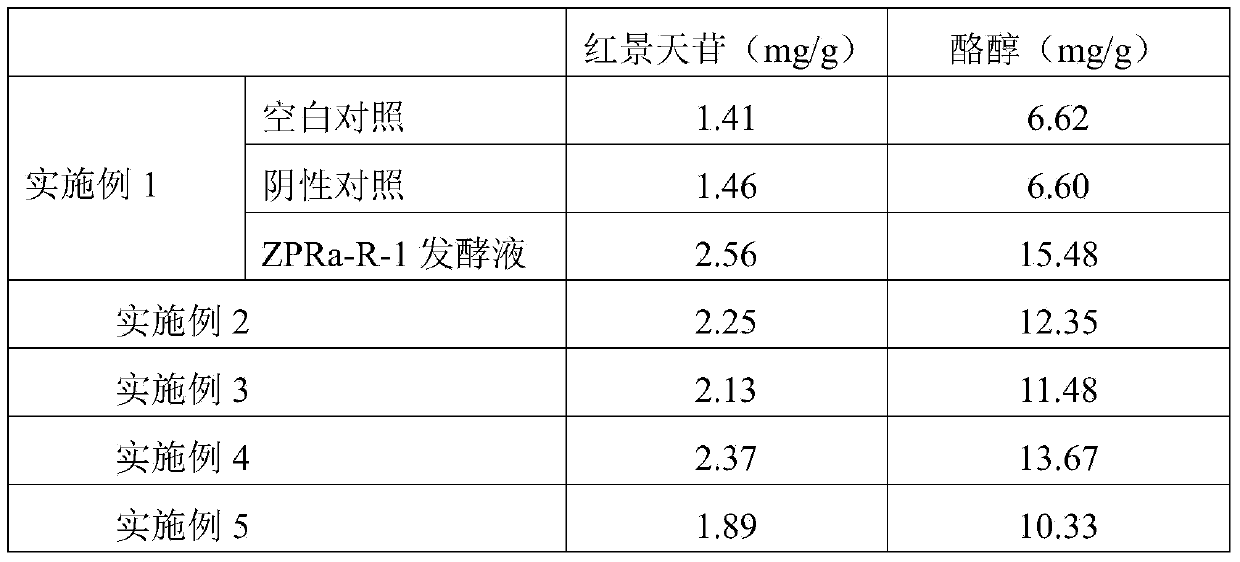Method for improving content of salidroside and tyrosol in rhodiola rosea tissue culture seedling
A technology of salidroside and rhodiola, which is applied in the field of plant tissue culture, can solve problems such as artificial cultivation of rhodiola, and achieve the effects of low cost, increased content, and simple operation
- Summary
- Abstract
- Description
- Claims
- Application Information
AI Technical Summary
Problems solved by technology
Method used
Image
Examples
Embodiment 1
[0022] (1) The fungus ZPRa-R-1 is activated and cultivated to a vigorous state, and 5 bacterium cakes with a diameter of 0.5cm are inserted into a 500mL Erlenmeyer flask equipped with 200mL PDA liquid medium, at 28°C, the rotation speed is Under the condition of 200r / min, culture in dark for 5 days, filter with four layers of gauze, separate the mycelium and fermentation broth, discard the mycelia, and rotate the fermentation broth to form a paste for later use.
[0023] According to the ratio of 2g: 1L = fermentation broth paste: MS medium (containing 0.5mg / L TDZ, 0.5mg / L NAA), add the fungal fermentation broth paste to MS medium to make fungus and Rhodiola rosea The symbiotic medium of tissue culture seedlings was sterilized at 121°C, and after cooling, healthy tissue culture seedlings of Rhodiola grandiflora were inoculated.
[0024] (2) Blank control: no fungal culture was added, and MS medium (containing 0.5mg / L TDZ, 0.5mg / L NAA) was used to directly culture Rhodiola gran...
Embodiment 2
[0028] The solid culture bacteria are directly symbiotic with the tissue culture seedlings, and the contents of salidroside and tyrosol in the rhodiola rosea tissue culture seedlings are increased.
[0029] (1) The fungus ZPRa-R-1 is activated and cultured to a vigorous state, ready for use.
[0030] (2) Use sterilized and cooled MS medium (containing 0.5mg / L TDZ, 0.5mg / L NAA) to inoculate healthy Rhodiola rosea tissue culture seedlings. Under sterile conditions, the vigorous fungus ZPRa-R-1 was inoculated on the medium close to the tissue culture seedlings, so that the fungus and Rhodiola rosea tissue culture seedlings could grow symbiotically, and the culture conditions were set according to two periods: ① Light for 14 hours hours, the temperature is 27°C, and the humidity is 72%; ②10 hours without light, the temperature is 22°C, and the humidity is 78%. The culture time was 20 days, the seedlings were harvested, dried, crushed, extracted, and measured according to the meth...
Embodiment 3
[0032] The fungus ZPRa-R-1 was activated and cultivated to a vigorous state, and 6 pieces of bacterium cakes with a diameter of 1.0cm were inserted into a 500mL Erlenmeyer flask containing 150mL of PDA liquid medium. Under dark cultivation for 8 days, filter with four layers of gauze, separate the mycelia from the fermentation broth, discard the mycelia, and rotate the fermentation broth to form a paste for later use.
[0033] According to the ratio of 4g: 1L = fermentation broth paste: MS medium (containing 1mg / L TDZ, 1mg / L NAA), add the fungal paste to MS medium to make fungal culture and Rhodiola grandiflora seedlings The symbiotic medium was sterilized at 121°C, and after cooling, the tissue-cultured seedlings of Rhodiola grandiflora were inoculated.
[0034] The culture conditions were set according to two periods: ① 16 hours of light, temperature 28°C, humidity 75%; ② non-light 8 hours, temperature 23°C, humidity 80%. The culture time was 30 days, the seedlings were har...
PUM
 Login to View More
Login to View More Abstract
Description
Claims
Application Information
 Login to View More
Login to View More - R&D
- Intellectual Property
- Life Sciences
- Materials
- Tech Scout
- Unparalleled Data Quality
- Higher Quality Content
- 60% Fewer Hallucinations
Browse by: Latest US Patents, China's latest patents, Technical Efficacy Thesaurus, Application Domain, Technology Topic, Popular Technical Reports.
© 2025 PatSnap. All rights reserved.Legal|Privacy policy|Modern Slavery Act Transparency Statement|Sitemap|About US| Contact US: help@patsnap.com

